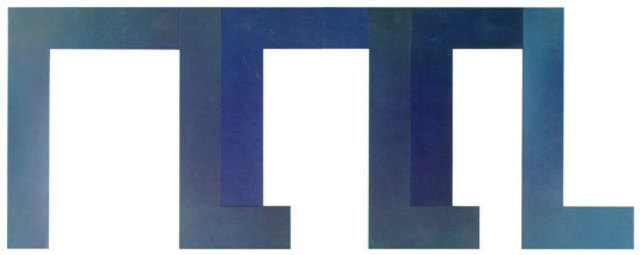
Description
David Novros's work received a great deal of critical attention in the late 1960s. Born in Los Angeles in 1941, he had his first one-person exhibition there in 1966 at the Dawn Gallery. Having moved to New York in 1964, he exhibited in 1967 at the New York Dawn Gallery and at the Park Place Gallery, an artists' cooperative. Along with the paintings of Brice Marden and other young artists, Novros's work was included in a number of important Minimal Art exhibitions.
Unlike most of the artists of his generation, Novros was trained as an academic painter. He first studied classical drawing at the age of thirteen, and in his own words, "at sixteen was making competent, romantic paintings."(1) His mature work, however, was influenced by the radical ideas of the Minimalist sculptor Donald Judd. In accordance with Minimalist ideas, Novros freed his paintings from the boundaries of a traditional rectangular structure in order to incorporate the environment and to establish perception of the art object as inseparable from its specific context. In early exhibitions, he showed works comprised of several geometrically shaped canvases arranged symmetrically, often without touching, around an axis. In several of these works, an undercoat of pigment suspended in an acrylic lacquer was covered with a second layer of iridescent pigment in the same medium. The opacity and evenness of the metallic surfaces, along with the unconventional use of several canvases, heightened the viewer's awareness of "objectness" in these paintings. These works did not fit into the traditional categories of painting or sculpture but, by interacting with the wall on which they hung, were closer to reliefs. In this way, they directed the viewer's attention to the real architectural conditions in which the object was seen.
The work in the Empire State Plaza Art Collection appears motivated by similar intentions. It consists of L-shaped sections arranged so that they appear to hang from a unifying horizontal. The separate parts are more integrated than they were in Novros's earlier works, yet the wall remains an essential part of the composition. The continuity between the space of the viewer and that of the painting is emphasized by the wall, which exists as part of both. Instead of using canvas supports with thick stretcher bars as in his earlier works, here Novros has painted on fiberglass, reducing the depth of the painting. Color is extremely important. It varies subtly between grays and blues and alters with changes in light. The eye is not pulled into the painting but led across the surface, the elusive color contrasting with the tangible forms of the individual sections. Reproduction of this image, including downloading, is prohibited without written authorization fromm ARS, 536 Broadway, 5th Floor, New York, NY 10112. Tel: 312.420.9160; email: info@arsny.com
Details
- Work Date:
- 1968
- Location:
- North Concourse
- Dimensions:
- 6'-11" x 18'-5 1/2"
- Medium:
- acrylic lacquer on fiberglass